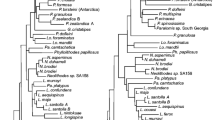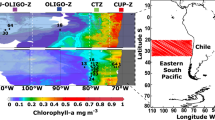Abstract
The phylogenetic relationships of the Antarctic krill Euphausia superba, the key species in the Antarctic food web, and other Antarctic and sub-Antarctic cuphausiids have been investigated using the 16S ribosomal mitochondrial gene. The phylogenetic reconstructions indicated that the Antarctic species form a monophyletic clade separated by the non-Antarctic species. The results revealed a large genetic divergence between the Antarctic (E. superba and E. crystallorophias) and sub-Antarctic species (E. vallentini). The time of separation between these species, estimated from the molecular data, is around 20 million years ago, which is comparable with the geological time of the formation of a circum-Antarctic water circulation and the Antarctic Polar Frontal Zone. The euphausiid molecular phylogeny therefore represents evidence for vicariant speciation.
Similar content being viewed by others
References
Amos AF (1984) Distribution of krill (Euphausia superba) and the hydrography of the Southern Ocean: large scale processes. J Crustacean Biol 4: 306–329
Avise JC (1994) Molecular markers, natural history and evolution. Chapman and Hall, London
Cunningham CW, Blackstone NW, Buss LW (1992) Evolution of king crabs from hermit crab ancestor. Nature, Lond 355: 539–542
Deacon G (1984) The Antarctic Circumpolar Ocean. Cambridge University Press, Cambridge
Eastman JT (1993) Antarctic fish biology. Evolution in a unique environment. Academic Press, San Diego
El-Sayed SZ (1994) Southern Ocean ecology: the BIOMASS perspective. Cambridge University Press, Cambridge
Felsenstein J (1985) Confidence limits on phylogenies: an approach using the bootstrap. Evolution 39: 783–791
Fevolden SE (1984) Biotic and physical environmental impact on genetic variation of krill. J Crustacean Biol 4: 206–223
Fevolden SE (1988) Biochemical genetics and population structure of Euphausia superba. Comp Biochem Physiol 90B: 507–513
Fevolden SE, Schneppenheim R (1989) Genetic homogeneity of krill (Euphausia superba Dana) in the Southern Ocean. Polar Biol 9: 533–539
Fischer W, Hureau JC (1985) FAO species identification sheets for fishery purposes. Southern Ocean (Fishing Areas 48, 58 and 88) (CCAMLR convention area). Vol. 1 and 2. Food and Agriculture Organization of the United Nations, Rome
Gordon AL, Goldberg RD (1970) Circumpolar characteristics of Antarctic waters. In: Bushnel VC (ed) Antarctic map folio series, Folio 13. American Geographical Society, New York
Gyllensten UB, Erlich HA (1988) Generation of single stranded DNA by polymerase chain reaction and its application to direct sequencing of the HLA-DQa locus. Proc natn Acad Sci USA 85: 7652–7656
Kimura M (1980) A simple method for estimating evolutionary rate of base substitutions through comparative studies of nucleotide sequences. J molec Evolut 16: 111–120
Kumar S, Tamura K, Nei M (1993) Molecular Evolutionary Gentics Analysis (MEGA). The Pennsylvania State University, University Park, Pa
Lynch JD (1989) The gauge of speciation: on the frequencies of modes of speciation. In: Otte D, Endler JA (eds) Speciation and its consequences. Sinauer Associates, Sunderland, Mass
Mackintosh NA (1972) Life cycles of Antarctic krill in relation to water and water conditions. “Discovery” Rep 36: 1–94
Mackintosh NA (1973) Distribution of postlarval krill in the Antarctic. “Discovery” Rep 36: 95–126
Marr JWS (1962) The natural history and geography of the Antarctic krill (Euphausia superba Dana). “Discovery” Rep 32: 33–464
Medlin LK, Lange M, Baumann MEM (1994) Genetic differentiation among three colony-forming species of Phaeocystis: further evidence for the phylogeny of the Prymnesiophyta. Phycologia 33: 199–212
Palumbi SR, Kessing B, Croom H, Martin A, McIntosh C, McMillan WO (1991) The simple fool's guide to PCR Version 2.0. University of Hawaii, Department of Zoology, Honolulu
Phan NV, Gomes V, Suzuki I, de AC Passos MJ (1989) Preliminary studies on chromosomes of Antarctic krill, Euphausia superba Dana. Polar Biol 10: 149–150
Saitou N, Nei M (1987) The neighbor-joining method: a new method for reconstructing phylogenetic trees. Molec Biol Evolut 4: 406–525
Sambrook J, Fritsch EF, Maniatis T (1989) Molecular cloning: a laboratory manual. Cold Spring Harbour Laboratory, Cold Spring Harbour, New York
Sanger F, Nicklen S, Coulson AR (1977) DNA sequencing with chain-terminating inhibitors. Proc natn Acad Sci USA 74: 5463–5467
Schneppenheim R, MacDonald CM (1984) Genetic variation and population structure of krill (Euphausia superba) in the Atlantic sector of Antarctic waters and off the Antarctic Peninsula. Polar Biol 3: 19–28
Smith SL, Schnack-Schiel SB (1990) Polar zooplankton. In: Smith WO J (ed) Polar oceanography, Part B: chemistry, biology and geology. Academic Press, San Diego, pp 527–598
Swofford DL (1993) Phylogenetic analysis using parsimony (PAUP). Illinois Natural History Survey, Champaign, Ill
Takezaki N, Rzhetsky A, Nei M (1995) Phylogenetic test of the molecular clock and linearized trees. Molec Biol Evolut 12: 832–833
Thiriot-Quiévreux C, Cuzin-Roudy J (1995) Karyological study of the Mediterranean krill Meganictiphanes norvegica (Crustacea: Euphausiacea). J Crustacean Biol 15: 79–85
Thompson JD, Higgins DG, Gibson TJ (1994) CLUSTAL W: improving the sensitivity of progressive multiple sequence alignment through sequence weighting, position, specific-gap penalties and weight matrix choice. Nucleic Acid Res 72: 4673–4680
Thomson MRA, Crame JA, Thomson JW (eds) (1991) Geological evolution of Antarctica. Cambridge University Press, Cambridge
Tingey RJ (ed) (1991) The geology of Antarctica. Oxford University Press, Oxford
Author information
Authors and Affiliations
Additional information
Communicated by M. Sarà, Genova
Rights and permissions
About this article
Cite this article
Patarnello, T., Bargelloni, L., Varotto, V. et al. Krill evolution and the Antarctic ocean currents: evidence of vicariant speciation as inferred by molecular data. Marine Biology 126, 603–608 (1996). https://doi.org/10.1007/BF00351327
Received:
Accepted:
Issue Date:
DOI: https://doi.org/10.1007/BF00351327




